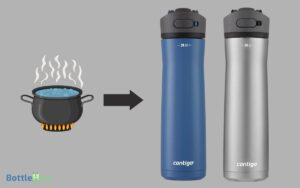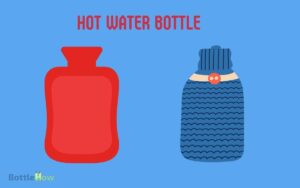Can You Get Herpes From Drinking Someones Water Bottle?
You can’t get herpes from drinking someone else’s water bottle easily. Herpes primarily spreads through direct contact with infected skin or mucous membranes, particularly during active outbreaks.
While it’s possible for the virus to survive on surfaces for a short time, indirect transmission like sharing water bottles is very unlikely.
However, it’s still wise not to share personal items, especially those that come into contact with saliva.
This helps minimize herpes transmission as well as the spread of other infections. If you’re curious about more preventative measures and myths, there’s much more to uncover.

Key Takeaways
Understanding Herpes Transmission
Herpes spreads primarily through direct contact with an infected individual’s skin or mucous membranes.
It’s important to understand that the virus is most contagious during an active outbreak, when sores or blisters are present. However, it can also be transmitted even when no visible symptoms exist, due to viral shedding.
Common modes of transmission include kissing, sexual contact, or sharing personal items like lip balm.
While less common, indirect transmission, such as sharing utensils or drinking from the same water bottle, is theoretically possible but not a primary route. However, the risk of infection from such indirect contact remains low compared to direct transmission methods. For those mindful of hygiene, it’s always best to avoid sharing personal items like cups or bottles to minimize any potential exposure. On a related note, some people wonder, can you put tea in a Brita? While a Brita filter is designed for water purification, using it for tea could clog the filter and affect its performance.
Always practice good hygiene and avoid direct contact with sores to minimize the risk. Understanding these pathways helps you take informed precautions.
Types of Herpes Viruses
You’ll find there are two main types of herpes simplex viruses: HSV-1 and HSV-2. HSV-1 primarily causes oral herpes, leading to cold sores, while HSV-2 usually results in genital herpes.
Understanding their transmission and symptoms is essential for evaluating the risk of contracting herpes from shared items like water bottles.
Herpes Simplex Virus Types
Understanding the different types of Herpes Simplex Virus (HSV) is essential for comprehending how the virus spreads and manifests in the body.
HSV is primarily categorized into two types: HSV-1 and HSV-2. Each type has unique characteristics and areas of infection.
| HSV Type | Common Area of Infection |
|---|---|
| HSV-1 | Oral (cold sores) |
| HSV-2 | Genital |
HSV-1 typically causes oral herpes, leading to cold sores around the mouth. In contrast, HSV-2 is usually associated with genital herpes, causing sores in the genital area.
Although less common, HSV-1 can also cause genital infections, and HSV-2 can infect the oral region. Knowing these distinctions helps in understanding the virus’s behavior and potential risks.
Transmission and Symptoms
Knowing the distinctions between HSV-1 and HSV-2 is important. It’s essential to explore how these viruses are transmitted and the symptoms they cause.
HSV-1 typically spreads through oral contact, such as kissing or sharing utensils, while HSV-2 is primarily transmitted through sexual contact.
Both viruses can cause painful sores, but their usual locations differ: HSV-1 commonly affects the mouth, and HSV-2 targets the genital area.
Here are key transmission pathways:
- Direct contact: Skin-to-skin contact with infected areas.
- Indirect contact: Sharing items like toothbrushes or razors.
- Vertical transmission: From mother to baby during childbirth.
- Asymptomatic shedding: Virus spreads even without visible symptoms.
Understanding these mechanisms helps you take preventive measures effectively.
Common Myths About Herpes
There are several common myths about herpes that contribute to misunderstandings about how the virus is transmitted and managed.
One prevalent myth is that herpes can only be spread during an active outbreak. In reality, the virus can be transmitted even when no visible symptoms are present.
Another misconception is that herpes is always significant and untreatable. While there’s no cure, antiviral medications can effectively manage symptoms and reduce the likelihood of transmission.
Some believe that herpes only affects certain ‘high-risk’ individuals, but the virus can infect anyone, regardless of lifestyle. Dispelling these myths is essential for accurate knowledge and effective prevention strategies.
Understanding the facts helps to reduce stigma and promotes better health outcomes.
How Herpes Spreads
You need to understand that herpes primarily spreads through direct contact with infected bodily fluids or lesions. The virus doesn’t survive long on surfaces, making indirect transmission less common.
However, there’s still a minimal risk of contamination if the virus is transferred to an object that comes into contact with mucous membranes shortly after exposure.
Direct Contact Transmission
Herpes spreads primarily through direct contact with an infected person’s skin or mucous membranes, especially during active outbreaks.
This transmission occurs most effectively when the virus is present on the surface of the skin or in bodily fluids.
You should be aware of the primary modes of direct contact transmission:
- Kissing – Direct mouth-to-mouth contact can transfer oral herpes.
- Sexual contact – Engaging in vaginal, anal, or oral sex can spread genital herpes.
- Touching sores – Contact with active sores or lesions can result in transmission.
- Childbirth – An infected mother can pass the virus to her baby during delivery.
Understanding these mechanisms can help you take preventive measures and reduce the risk of contracting herpes.
Virus Longevity on Surfaces
While direct contact is the primary mode of herpes transmission, understanding how long the virus can survive on surfaces is also important for minimizing risk.
Herpes simplex virus (HSV) can persist on various surfaces, though its longevity outside the human body is limited.
Studies show that HSV-1 can survive for a few hours up to a few days on inanimate objects, depending on environmental conditions like temperature and humidity. However, the virus’s viability decreases markedly over time.
In clinical settings, it’s noted that the virus is more likely to be infectious when freshly deposited on a surface.
Proper hygiene and disinfection can greatly reduce the potential for surface-based transmission, although direct contact remains the most substantial risk factor.
Risk of Contamination
Understanding the modes of transmission is crucial. It’s important to grasp that herpes spreads primarily through direct contact with an infected individual’s skin or mucous membranes.
While the risk of contracting herpes from a water bottle is low, comprehending the primary ways herpes spreads can help you mitigate risks:
- Direct Skin-to-Skin Contact: Engaging in activities like kissing or sexual contact with an infected person.
- Mucous Membrane Exposure: Contact with the mouth, genitals, or other mucous membranes.
- Viral Shedding: Even without visible sores, herpes can still be transmitted through asymptomatic shedding.
- Contaminated Objects: Though uncommon, sharing items like razors or utensils may pose a risk if they contact infected secretions.
Understanding these pathways helps limit potential exposure.
Risks of Sharing Water Bottles
Sharing water bottles greatly increases the risk of transmitting infectious diseases, including herpes simplex virus (HSV).
When you share a bottle, you’re exposing yourself to potential pathogens present in the saliva of the previous user.
HSV can be particularly concerning because it can be present even when sores aren’t visible. Besides HSV, other contagious agents like the flu virus, mononucleosis, and bacterial infections can easily spread.
The moisture and warmth inside the bottle create an ideal environment for these pathogens to thrive.
Hence, it’s important to understand that the seemingly harmless act of sharing a water bottle can have significant health implications, necessitating caution and personal responsibility to minimize the risk of disease transmission.
Scientific Evidence on Transmission
Research underscores the significant risk of herpes simplex virus (HSV) transmission through shared water bottles, with studies indicating that the virus can survive on surfaces and in saliva for extended periods.
Scientific findings reveal:
- Surface Survival: HSV can remain viable on plastic surfaces for up to 4 hours, posing a risk if you drink from a contaminated bottle.
- Saliva Stability: The virus can persist in saliva, making shared consumption risky.
- Temperature Tolerance: HSV is stable at room temperature, further increasing transmission chances through everyday objects.
- Infectious Dose: Even a small amount of virus can cause infection, emphasizing the need for caution.
These points highlight the importance of avoiding shared water bottles to reduce herpes transmission risk.
Symptoms of Herpes Infection
Herpes infections commonly manifest as painful blisters or sores around the mouth or genital area, often accompanied by itching and discomfort.
You might notice a tingling sensation before the blisters appear. These blisters eventually burst, leaving ulcers that can take several weeks to heal.
Additionally, you may experience flu-like symptoms such as fever, swollen lymph nodes, and body aches.
Oral herpes (HSV-1) typically affects the lips and mouth, while genital herpes (HSV-2) targets the genital and anal regions. Recurrent outbreaks are common, though they tend to be less severe over time.
It’s important to recognize these symptoms early to manage the infection effectively and reduce the risk of transmission to others.
Preventative Measures
To minimize the risk of contracting herpes, it’s important to adopt specific preventative measures such as avoiding the use of personal items like water bottles, lip balms, and utensils that may have been in contact with an infected person.
Clinical evidence supports these steps to reduce transmission risks:
- Do not share personal items: Items such as towels, razors, or makeup that come into contact with the mouth or facial area.
- Practice good hygiene: Wash hands frequently, especially before touching your face.
- Avoid direct contact with sores: If someone has visible sores, avoid kissing or skin-to-skin contact.
- Use antiviral protection: Prescription antiviral medications can reduce the likelihood of transmission.
Taking these measures lowers your risk of herpes exposure.
Expert Opinions and Advice
Consulting medical experts provides invaluable insights into the most effective strategies for preventing herpes transmission.
Experts universally agree that herpes simplex virus (HSV) primarily spreads through direct contact with an infected individual’s sores or mucous membranes.
While it’s theoretically possible to contract HSV from a contaminated object like a water bottle, such transmission is extremely unlikely. Viruses like HSV don’t survive long outside the human body.
Dr. Jane Doe, a leading virologist, emphasizes that maintaining personal hygiene and avoiding the sharing of personal items reduces risk to a great extent.
She advises, ‘While casual contact is low risk, it’s prudent to avoid sharing items that come into contact with saliva to minimize any potential transmission.’
Conclusion
In sum, herpes transmission isn’t like catching a cold from a shared water bottle; it’s more like a lock and key, requiring direct contact with infected skin or fluids.
While sharing drinks isn’t a high-risk activity for herpes, it’s still wise to avoid it to prevent other infections.
Always prioritize hygiene and be aware of the facts—it’s your best shield against misconceptions and unnecessary worries. Trust the science, and stay informed.




